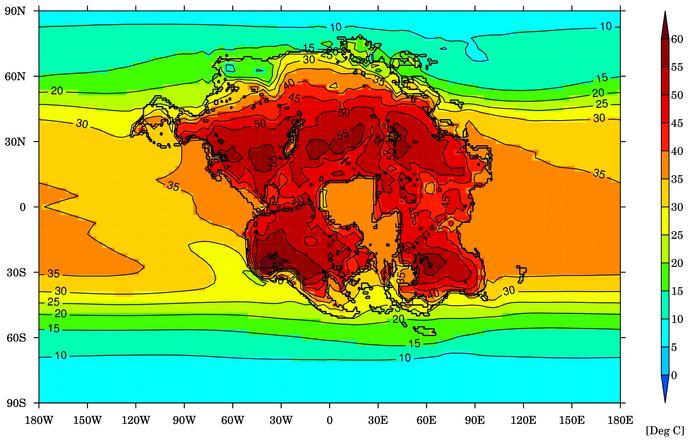Climate change study puts expiration date on all mammals
Study reveals formation of massive, ultra-hot and largely uninhabitable supercontinent called Pangea Ultima
Your support helps us to tell the story
From reproductive rights to climate change to Big Tech, The Independent is on the ground when the story is developing. Whether it's investigating the financials of Elon Musk's pro-Trump PAC or producing our latest documentary, 'The A Word', which shines a light on the American women fighting for reproductive rights, we know how important it is to parse out the facts from the messaging.
At such a critical moment in US history, we need reporters on the ground. Your donation allows us to keep sending journalists to speak to both sides of the story.
The Independent is trusted by Americans across the entire political spectrum. And unlike many other quality news outlets, we choose not to lock Americans out of our reporting and analysis with paywalls. We believe quality journalism should be available to everyone, paid for by those who can afford it.
Your support makes all the difference.Unprecedented global warming will wipe out all mammals during a mass extinction event in about 250 million years, according to a new study.
The world’s continents are predicted to eventually merge once again to form an ultra-hot, dry and largely uninhabitable supercontinent called Pangea Ultima, said the climate change research, published on Monday in the journal Nature Geoscience.
Climate change that takes place over millennia differs from the man-made climate crisis which has been largely caused by the burning of fossil fuels.
Supercomputer simulations of the distant future were used by scientists that included those from the University of Bristol to project how global temperatures are set to further increase as the sun becomes brighter and emits more energy.
The movement of the Earth’s tectonic plates is also expected to result in the formation of another supercontinent, which could spark more frequent volcanic eruptions to produce huge releases of carbon dioxide into the atmosphere, further warming the planet, researchers said.
Until now, mammals – including humans – have managed to survive on Earth thanks to their ability to adjust to weather extremes via adaptations such as fur and hibernating in the cold as well as short spells of hibernation.
While mammals have adapted to survive cold temperatures, their upper-temperature tolerance has remained constant over the millions of years of their evolution.
Thus, prolonged excessive heat as predicted by the simulation is much harder to overcome, making the Earth ultimately unsurvivable for mammals.
“The newly emerged supercontinent would effectively create a triple whammy, comprising the continentality effect, hotter sun and more CO2 in the atmosphere, of increasing heat for much of the planet,” said the study’s lead author Alexander Farnsworth from the University of Bristol.
The result, researchers said, is a “mostly hostile” planet devoid of food and water sources for mammals.
“Widespread temperatures of between 40 to 50 degrees Celsius, and even greater daily extremes, compounded by high levels of humidity would ultimately seal our fate,” Dr Farnsworth said.
“Humans – along with many other species – would expire due to their inability to shed this heat through sweat, cooling their bodies,” he said.

The supercomputer simulation suggests the planet may remain largely habitable until this seismic landmass change in the deep future.
But when the supercontinent forms, the research indicates only about 8 and 16 per cent of Earth’s landmass would be habitable for mammals.
In the study, scientists applied climate models simulating temperature, wind, rain and humidity trends for Pangea Ultima expected to form in the next 250 million years.
They also used models of tectonic plate movement as well as ocean chemistry and biology to predict future levels of carbon dioxide.

Researchers highlighted, however, that it is important to not lose sight of the ongoing global climate crisis resulting from human emissions of greenhouse gases.
“While we are predicting an uninhabitable planet in 250 million years, today we are already experiencing extreme heat that is detrimental to human health. This is why it is crucial to reach net-zero emissions as soon as possible,” study co-author Eunice Lo said.
“We think CO2 could rise from around 400 parts per million (ppm) today to more than 600 ppm many millions of years in the future. Of course, this assumes that humans will stop burning fossil fuels, otherwise we will see those numbers much, much sooner,” said Benjamin Mills, another author of the study from the University of Leeds.
The findings also have implications for finding other liveable planets, hinting that the landmass layout for a distant world could be a key factor when determining how liveable it may be for humans.
“The outlook in the distant future appears very bleak. Carbon dioxide levels could be double current levels,” Dr Farnsworth said.
“With the Sun also anticipated to emit about 2.5 per cent more radiation and the supercontinent being located primarily in the hot, humid tropics, much of the planet could be facing temperatures of between 40-70C,” he said.




Join our commenting forum
Join thought-provoking conversations, follow other Independent readers and see their replies
Comments